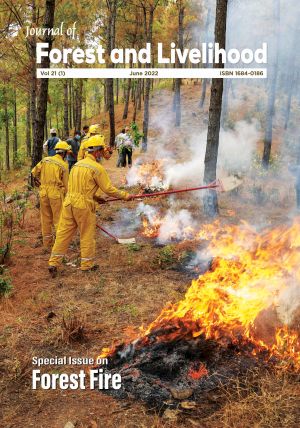Unravelling the Local Dynamics of Increasing Fires in Community Forests of Mid-hills of Nepal
DOI:
https://doi.org/10.3126/jfl.v21i1.56587Keywords:
Collective actions, forest fire, forest management, forest-people-fire relationshipAbstract
Forest fire is a global phenomenon and is having unprecedented impacts across continents. Nepal is not an exception to the increasing impacts, where hundreds of acres of forests is lost, or damaged, to forest fire. The severity of forest fire is on the rise in recent decades, wherein community forests have witnessed effects of the calamity over the recent years. This paper investigates the local factors behind the increasing frequency and severity of forest fires in mid-hills of Nepal. The paper draws on three separate cases from the research sites, involving five years of ‘Enhancing Livelihoods from Improved Forest Management in Nepal (EnLiFT2)’ project's team observations in Bhumlu rural municipality and Chautara Sangachokgadhi municipality of Kavrepalanchok and Sindhupalchok district respectively. This is complemented by informant interviews taken with 25 individuals. The paper primarily examines forest-people-fire relationship to demonstrate the weakening collective actions among the community forest user groups (CFUGs) as an important factor for increasing forest fires in the mid-hills of Nepal. We found the changing forest-people relationship, weakening CFUG governance, and increasing regulatory impositions as important factors driving the alienation of users from the forest thus, undermining collective action in forest management. We argue that strengthening collective action on better forest management to prevent forest fire is crucial over adopting mitigation techniques. The alienation of forest user groups from their forest in the changing socio-economic and forest management context can be addressed to strengthening the collective action for better forest management and ultimately to forest fire prevention and management.
Downloads
Downloads
Published
How to Cite
Issue
Section
License

This work is licensed under a Creative Commons Attribution-NonCommercial 4.0 International License.
CC-BY-NC: This license allows reusers to distribute, remix, adapt, and build upon the material in any medium or format for noncommercial purposes only, and only so long as attribution is given to the creator.





